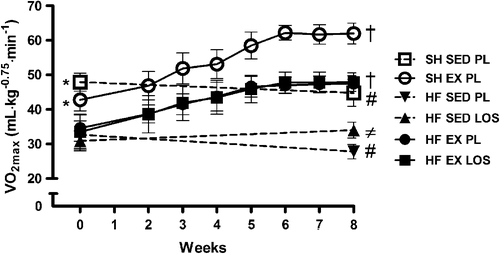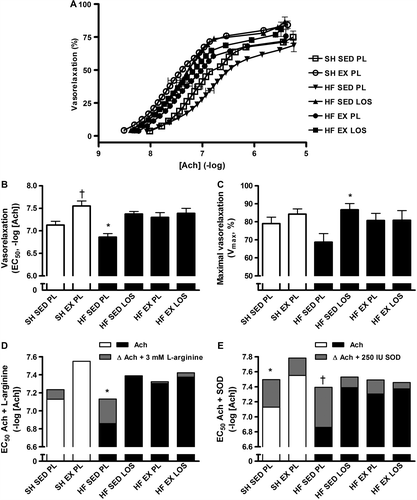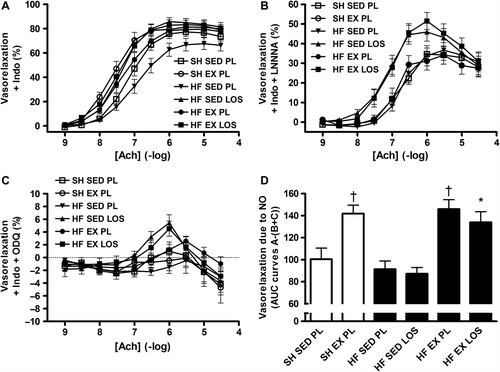Figures & data
Table I. Experimental interventions.
Table II. Left ventricular pressure recordings and infarct sizes.
Figure 1. Maximal oxygen uptake (VO2max) as a measure of exercise capacity. VO2max in sham-operated (SH) rats was 40% higher (*p < 0.01) than in those with heart failure (HF) before the exercise training program (pre-test). Post-tests indicated that VO2max increased 40% by exercise training (EX) in SH and HF rats; † (p < 0.01), and by 20% in losartan (LOS)-treated sedentary (SED) HF rats compared to placebo (PL)-controlled HF rats; ≠ (p < 0.01), respectively. Note that HF EX PL and HF EX LOS curves sit on top of each other. Also, SH SED PL and HF SED PL rats decreased VO2max from pre-to post-tests; # (p < 0.05).

Figure 2. A: Heart failure (HF) reduced the acetylcholine (Ach)-mediated vasorelaxation of aorta as indicated by the right shifted dose-response curve of sedentary (SED) HF rats on placebo (PL), whereas exercise training and losartan corrected for this dysfunction. B: Sensitivity to acetylcholine (EC50); note the y-axis has a logarithmic scale. Aorta segments of the SED HF rats relaxed less than all the other groups (*p < 0.05). Interventions with exercise training (EX), losartan (LOS) or a combination of both (EX LOS) improved endothelial sensitivity to Ach to levels comparable with SED sham-operated (SH) rats, whereas SH EX rats exceeded SED SH rats (†p < 0.01). C: Maximal vasorelaxation was increased in LOS-treated SED HF rats compared to PL-controlled SED HF rats (*p < 0.05). D: EC50-values of Ach-mediated vasorelaxation (white and black bars), with delta EC50-values (grey bars) indicating difference in Ach-mediated vasorelaxation after addition of 3 mM L-arginine; this maneuver increased the response in HF-SED-PL (*p < 0.05). E: EC50-values of Ach-mediated vasorelaxation (white and black bars), with delta EC50-values (grey bars) indicating difference in Ach-mediated vasorelaxation after addition of 250 IU superoxide dismutase (SOD); this maneuver increased the responses in SH-SED-PL and HF-SED-PL (*p < 0.05 and †p < 0.01).

Figure 3. A: Acetylcholine (Ach)-mediated vasorelaxation in the presence of 10 − 5 M indomethacin (Indo). B: Ach-mediated vasorelaxation in the presence of 10 − 4 M LNNA and 10 − 5 M Indo, with a trend (p = 0.12) toward an increase in vasorelaxation in the heart failure (HF) rats on losartan (LOS) vs. placebo (PL)-controlled sedentary (SED) or exercise training (EX) HF or sham-operated (SH) rats. C: Ach-mediated vasorelaxation in the presence of 10 − 5 M ODQ and 10 − 5 M Indo. D: Vasorelaxation due to nitric oxide (NO) was calculated by subtracting the area under curve (AUC) of the graphs in panels B and C from the AUC of panel A (A-(B + C)). HF-EX-LOS vs. HF-SED-PL and HF-SED-LOS: *p < 0.05; SH-EX-PL and HF-EX-PL vs. HF-SED-LOS, HF-SED-PL and SH-SED-PL: †p < 0.01.
